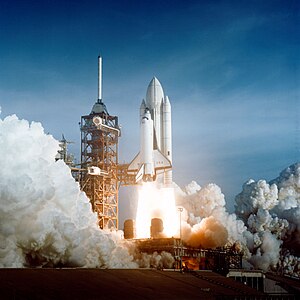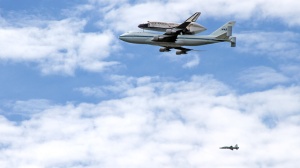Put frankly, the Space Shuttle is probably the most powerful machine ever constructed. One of the earliest astronauts aptly described the Shuttle as “A very beautiful butterfly bolted to a bullet”!
During launch the three solid-rocket boosters output 37 MILLION horsepower sucking fuel through a 17-inch diameter pipe at a rate that would empty an Olympic size swimming pool in 10 seconds. In fact, the boosters produce so much thrust that by the time the tail has cleared the tower it is already travelling at 120 mph. Thirty seconds later…BOOM there goes the sound barrier; 8 minutes later…we’ve drained 500,000 gallons of fuel and are now at the edge of outer space hurtling along at 17,500 mph. Quite an achievement considering that the first Space Shuttle Columbia had its virgin lift-off only 34 years after the first supersonic flight in 1947.
Besides escaping Earth’s gravitational field, returning safely to earth is another “issue”. As the space shuttle literally collides with the gases in the Earth’s atmosphere during re-entry at Mach 28 (8 km/s ≈ 18,000 mph), a hefty hypersonic shock wave occurs ahead of the shuttle nose. The compression of the gases across the shockwave causes gas temperatures of 12,000 K (11,727 C or 21,140 F), which is hotter than the surface of the sun. For this reason, reinforced carbon-carbon (RCC) panels are attached to the nose and leading edges of the wing to protect the Shuttle main structure from melting. Damage to these RCC by a piece of foam debris during launch resulted in the tragic Columbia accident in 2003.
The Space Shuttle is perhaps the greatest of all engineering accomplishments because it exhibits the most human of all qualities – a fateful flaw. For this reason the air-parade of the Discovery this week was a worthy final paragraph of an engineering story that has its permanent place in history. Since the Space Shuttle is inherently connected with the childhood dreams of space exploration of our generation it is a sad, albeit necessary, ending to a program that has outrun its purpose and funding. NASA’s future aims of exploration are in deep space, which will extend the limits of our current reach and lead to absolutely astounding novel technologies. We might have to wait a while for the next manned spacecraft, but I am well excited for what NASA has in mind. One thing is for sure: it’s going to be amazing, mind-blowing and an inspiration for future generation of engineers. Just like it has always been!
References
(1) Clarkson, J (2004). I know you got soul. Penguin Books, London.
(2) http://gizmodo.com/5902669/the-best-shot-of-the-space-shuttles-amazing-goodbye-flight-youll-see-today
Related Posts
Sign-up to the monthly Aerospaced newsletter
Recent Posts
- Podcast Ep. #49 – 9T Labs is Producing High-Performance Composite Materials Through 3D Printing
- Podcast Ep. #48 – Engineering Complex Systems for Harsh Environments with First Mode
- Podcast Ep. #47 – Möbius Aero and MμZ Motion: a Winning Team for Electric Air Racing
- Podcast Ep. #46 – Tow-Steered Composite Materials with iCOMAT
- Podcast Ep. #45 – Industrialising Rocket Science with Rocket Factory Augsburg
Topics
- 3D Printing (4)
- Aerodynamics (29)
- Aerospace Engineering (11)
- Air-to-Air Refuelling (1)
- Aircraft (16)
- Autonomy (2)
- Bio-mimicry (9)
- Case Studies (15)
- Composite Materials (25)
- Composites (7)
- Computational Fluid Dynamics (2)
- Contra-Rotation (1)
- Design (2)
- Digitisation (2)
- Drones (1)
- Education (1)
- Electric Aviation (11)
- Engineering (23)
- General Aerospace (28)
- Gliders (1)
- Helicopters (3)
- History (26)
- Jet Engines (4)
- Machine Learning (4)
- Manufacturing (12)
- Military (2)
- Modelling (2)
- Nanomaterials (2)
- NASA (2)
- New Space (11)
- News (3)
- Nonlinear Structures (1)
- Novel Materials/Tailored Structures (14)
- Personal Aviation (5)
- Podcast (45)
- Propulsion (9)
- Renewable Energy (2)
- Renewables (1)
- Rocket Science (17)
- Satellites (8)
- Shape Adaptation (1)
- Smart Materials (1)
- Space (12)
- Space Junk (1)
- Sport Airplanes (2)
- Startup (19)
- STOL (1)
- Structural Efficiency (5)
- Structural Mechanics (1)
- Superalloys (1)
- Supersonic Flight (2)
- Technology (18)
- UAVs (2)
- Virtual Reality (2)
- VTOL (3)
- Privacy & Cookies: This site uses cookies. By continuing to use this website, you agree to their use.
To find out more, including how to control cookies, see here: Cookie Policy



